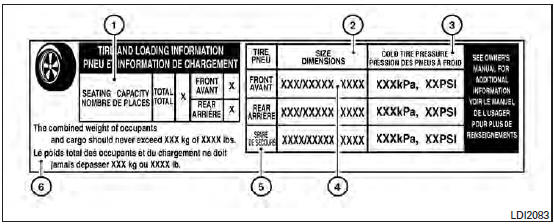Nissan Rogue Owners Manual: Tire pressure
Tire Pressure Monitoring System (TPMS)
| WARNING Radio waves could adversely affect electric medical equipment. Those who use a pacemaker should contact the electric medical equipment manufacturer for the possible influences before use |
This vehicle is equipped with TPMS. It monitors tire pressure of all tires except the spare. When the low tire pressure warning light is lit and the Tire Pressure Low - Add Air warning appears in the vehicle information display, one or more of your tires is significantly under-inflated. If equipped, the system also displays pressure of all tires (except the spare tire) on the display screen by sending a signal from a sensor that is installed in each wheel.
The TPMS will activate only when the vehicle is driven at speeds above 16 MPH (25 km/h). Also, this system may not detect a sudden drop in tire pressure (for example a flat tire while driving).
For additional information, refer to ŌĆ£Low tire pressure warning lightŌĆØ in the ŌĆ£Instruments and controlsŌĆØ section and ŌĆ£Flat tireŌĆØ in the ŌĆ£In case of emergencyŌĆØ section.
Tire inflation pressure
Check the tire pressures (including the spare) often and always prior to long distance trips. The recommended tire pressure specifications are shown on the F.M.V.S.S./C.M.V.S.S. certification label or the Tire and Loading Information label under the ŌĆ£Cold Tire PressureŌĆØ heading.
The Tire and Loading Information label is affixed to the driver side center pillar. Tire pressures should be checked regularly because:
- Most tires naturally lose air over time.
- Tires can lose air suddenly when driven over potholes or other objects or if the vehicle strikes a curb while parking.
The tire pressures should be checked when the tires are cold. The tires are considered COLD after the vehicle has been parked for 3 or more hours, or driven less than 1 mile (1.6 km) at moderate speeds.
The TPMS with Easy Fill Tire Alert provides visual and audible signals outside the vehicle for inflating the tires to the recommended COLD tire pressure. For additional information, refer to ŌĆ£TPMS with Easy Fill Tire AlertŌĆØ in the ŌĆ£Starting and drivingŌĆØ section of this manual.
Incorrect tire pressure, including under inflation, may adversely affect tire life and vehicle handling.
WARNING
|

Tire and loading information label
- Seating capacity: The maximum number of occupants that can be seated in the vehicle.
- Tire size - refer to ŌĆ£Tire labelingŌĆØ in this section.
- Cold tire pressure: Inflate the tires to
this pressure when the tires are cold.
Tires are considered COLD after the vehicle has been parked for 3 or more hours, or driven less than 1 mile (1.6 km) at moderate speeds. The recommended cold tire inflation is set by the manufacturer to provide the best balance of tire wear, vehicle handling, driveability, tire noise, etc., up to the vehicleŌĆÖs GVWR.
- Original tire size: The size of the tires originally installed on the vehicle at the factory.
- Spare tire size.
- Vehicle load limit: Refer to ŌĆ£Vehicle loading informationŌĆØ in the ŌĆ£Technical and consumer informationŌĆØ section of this manual.

Checking tire pressure
- Remove the valve stem cap from the tire.
- Press the pressure gauge squarely onto the valve stem. Do not press too hard or force the valve stem sideways, or air will escape. If the hissing sound of air escaping from the tire is heard while checking the pressure, reposition the gauge to eliminate this leakage.
- Remove the gauge.
- Read the tire pressure on the gauge stem and compare to the specification shown on the Tire and Loading Information label.
- Add air to the tire as needed. If too
much air is added, press the core of
the valve stem briefly with the tip of
the gauge stem to release pressure.
Recheck the pressure and add or release air as needed.
- Install the valve stem cap.
- Check the pressure of all other tires, including the spare.

 Wheels and tires
Wheels and tires
If you have a flat tire, refer to ŌĆ£Flat tireŌĆØ in
the ŌĆ£In case of emergencyŌĆØ section of this
manual for additional information. ...
 Tire labeling
Tire labeling
Example
Federal law requires tire manufacturers to
place standardized information on the
sidewall of all tires. This information identifies
and describes the fundamental
characteristics of the ...
Other materials:
Fuses
Two types of fuses are used. Type A is used in
the fuse boxes in the engine compartment. Type
B is used in the passenger compartment fuse
box.
Type A fuses are provided as spare fuses. They
are stored in the passenger compartment fuse
box.
Type A fuses can be installed in the engine
co ...
Wiring diagram
AWD SYSTEM
Wiring Diagram
...
P2118 throttle control motor
DTC Description
DTC DETECTION LOGIC
DTC No.
CONSULT screen terms
(Trouble diagnosis content)
DTC detecting condition
P2118
ETC MOT-B1
(Throttle actuator control motor current
range/performance)
ECM detects short in both circuits between ECM and throttle control ...
